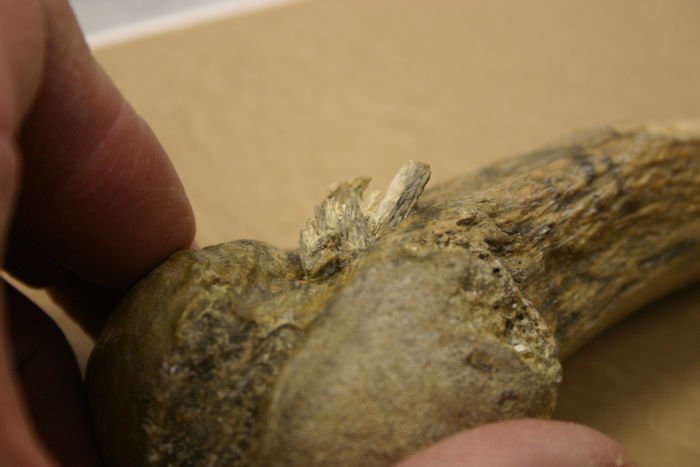The Manis bone projectile point has been determined by a team of academics to be the oldest bone-based weapon discovered in the Americas, dating back 13,900 years, under the direction of a professor at Texas A&M University.
The team's reconstruction of the bone point. Credit: Center for the Study of the First Americans, Texas A&M University
The researchers examined bone pieces found within a mastodon rib bone that Carl Gustafson first discovered during an excavation at the Manis site in Washington state between 1977 and 1979.
Waters and his team identified each piece of bone using a CT scan and 3D modeling software to demonstrate that it was the point of a projectile manufactured from the bone of a Mastodon, an extinct relative of the elephant.
Dr. Michael Waters, renowned professor of anthropology and head of Texas A&M's Center for the Study of First Americans, explained, "We isolated the bone fragments, printed them out, and assembled them." This was the tip of a bone projectile point, as was made very obvious. The oldest bone projectile point found in the Americas and the earliest direct indication of mastodon hunting in the continent.
According to Waters, the Manis point, which dates to 13,900 years ago, is 900 years older than projectile points connected to the Clovis people, whose stone tools he has previously studied. Spear points made by the Clovis people, who lived between 13,050 and 12,750 years ago, have been discovered in Texas and other locations around the US.
The fact that Manis is the first and only bone tool older than Clovis is significant. Only stone tools have been discovered at the second pre-Clovis site, according to Waters. This demonstrates that the Native Americans produced and utilized bone weapons as well as maybe other bone implements.
According to him, the projectile from the hunter's missed shot became caught in the mastodon's rib and is the sole reason the Manis specimen was preserved.
According to Waters, "we demonstrate that the bone used to make the point appears to have originated from the leg bone of another mastodon and was purposefully shaped into a projectile point form." "The bone-pointed spear was hurled at the mastodon. It cut through the tissue and hide before coming into contact with the rib. The hunter tried to go between the ribs to damage the lung function, but he failed and hit the rib instead.
In an earlier investigation of the rib bone by Waters, which was published in 2011 in Science, the age of the bone was established by radiocarbon dating, and the mastodon ancestry of the bone fragments was established through genetic analysis.
"In our new study, we set out to isolate the bone fragments using CT images and 3D software," the researcher added. "We were able to produce 3D representations of each element that were printed at a scale of six. The specimen's appearance before it entered and fractured in the rib was then demonstrated by putting the parts back together.
A close-up angle shows the bone point embedded in the mastodon's rib. Credit: Center for the Study of the First Americans, Texas A&M University
Other than the fact that they were some of the earliest Indigenous people to visit the Americas, nothing is known about the people who utilized the Manis spear point. According to Waters, the Manis site and others are shedding light on archaeology.
He remarked, "It appears that the first immigrants to the Americas arrived by boat." "They went south along the coast of the North Pacific. They eventually made it over the Canadian ice sheets and arrived on the Pacific Northwest coast.
It's fascinating to notice that Paisley Caves in Oregon is 14,100 years old, whereas Coopers Ferry in Idaho is 16,000 years old. We also cover the 13,900-year-old Manis site here. The Northwestern region of the United States thus appears to include a concentration of ancient sites that date from 16,000 to 14,000 years ago and precede Clovis. These locations probably mark the earliest immigrants to the Americas at the conclusion of the last ice age, along with their descendants.








